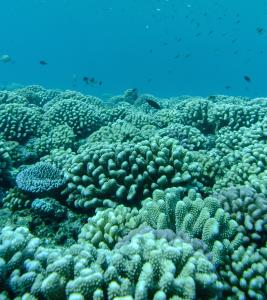New research provides ‘oases’ of hope for the future of coral reefs
University of Hawaiʻi at MānoaDirector, Hawaii Institute of Marine Biology, School of Ocean and Earth Science and Technology
Marcie Grabowski, (808) 956-3151
Outreach Specialist, School of Ocean and Earth Science and Technology
Amidst dire reports about the health of the world’s coral reefs, a team of 18 researchers, including several with ties to the Hawai‘i Institute for Marine Biology (HIMB) at the University of Hawai‘i at Mānoa School of Ocean and Earth Science and Technology (SOEST), have found coral reef “oases” that provide hope that all is not lost for these beautiful ecosystems.
The team, led by California State University, Northridge marine biologist Peter Edmunds; director of HIMB Ruth Gates; and U.S. Geological Survey (USGS) research marine biologist Ilsa Kuffner, developed a framework for identifying specific coral reefs in the world’s oceans where corals appear to be thriving, oases. They hope their findings, published today in the Journal of Applied Ecology, will encourage further study into why these communities of corals are surviving while so many more are not, and inspire efforts to identify similar oases in other ecosystems.
“Over the last 12 to 24 months, damage to coral reefs worldwide has appeared at an alarming rate, with deaths driven by the most recent El Niño, compounded by climate change induced ocean warming” said Edmunds. “But there are still places that are doing surprisingly well. These coral reef oases focus the attention on environments and communities that can help enhance coral conservation efforts.”
“Coral reefs are in rapid, global decline,” said Dan Thornhill, program director in the National Science Foundation’s Division of Ocean Sciences, which funded a substantial portion of the ecological investigations upon which this compilation study is based. “This timely and much-needed paper identifies coral reefs that are doing better than most, places that may provide a refuge against the worst effects of climate change.”
The 18 researchers have extensive knowledge about the conditions of coral reefs in the Pacific and the Caribbean. With support from the USGS John Wesley Powell Center for Analysis and Synthesis they developed a framework for identifying oases within four coral reef regions that have been studied for decades, in many cases by many of their own team members. Their framework considers the health of coral communities, how often they had been disturbed, and how long they had remained in a healthy or unhealthy state.
The researcher team identified 38 oases locations categorized as either “escape,” “resist" or “rebound” oases. Escape oases are coral communities that have been able to avoid disasters such as bleaching, invasions from coral-eating sea stars or the wrath of hurricanes. Resist oases are coral communities that appear hardy and resistance to environmental challenges. Rebound oases are coral communities that have suffered damage like many other reefs, but have rebounded to a coral-dominated state.
Gates said she has been “blown away by the capacity of the some badly damaged reefs in Hawai‘i to recover from past disturbances. There are areas in Hawai‘i which are remarkable example of oases.”
Given the 38 oases the researchers have identified, Edmunds said it is logical to assume that there are more coral oases in the rest of the world’s oceans. “We are optimistic that our coral reef oases are signs of hope for the future, rather than the last gasp of a dying ecosystem,” he said.
With this study, the co-authors provide conservationists and policy makers with a tool to identify areas that warrant stronger protection or specific management strategies, as these intact ecosystems may be able to catalyze broader ecosystem recovery.
* * *
Study co-authors are Peter Edmunds, California State University, Northridge; James R. Guest, Newcastle University; Ruth Gates, University of Hawai‘i; Ilsa Kuffner, U.S. Geological Survey (USGS) St. Petersburg Coastal and Marine Science Center; Andreas Andersson, Scripps Institution of Oceanography at UC San Diego; Brian Barnes, University of South Florida; Iliana Chollett, Smithsonian Marine Station; Travis Courtney, Scripps Institution of Oceanography; Robin Elahi, Stanford University; Kevin Gross, North Carolina State University; Beth Lenz, University of Hawai‘i; Satoshi Mitarai, Okinawa Institute of Science and Technology Graduate University; Peter Mumby, University of Queensland; Hannah Nelson, CSUN; Britt Parker, National Oceanic and Atmospheric Administration; Hollie Putnam, the University of Rhode Island; Caroline Rogers, USGS Wetland and Aquatic Research Center; and Lauren Toth, USGS St. Petersburg Coastal and Marine Science Center.
The USGS John Wesley Powell Center for Analysis and Synthesis funded the Working Group that led to the publication of this study.


